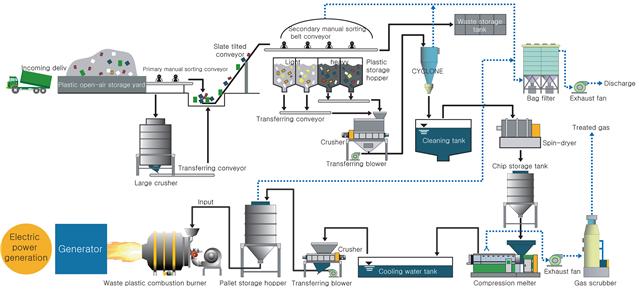
 Introduction Technology Introduction Technology |
|
|
|
|
|
|
|
|
 Manufactured Product Manufactured Product |
|
|
|
 |
 |
> Technology > Pellet fuel |
|
|
 |


This technology makes use of heat generated by using and combusting pellet fuel made from melting nonrenewable high-caloric waste plastic as a fuel of the pellet combustion burner.
Form of technologies
Drum-rotation melting method
Principle of technologies
- After pellet is made by melting crushed waste plastic, the pellet is combusted at the temperature of 1,000~1,300℃ inside the combustion burner in the processes of liquefaction -> evaporation -> ignition.
※ Pellet fuel
- It is a fuel of a certain size made with the process of extrusion molding of soft plastic such as LDPE and PS.
- It is a fuel of a certain size made with the process of crushing of hard plastic such as PETE, HEPE, and PP.

○ Note) Analysis results of Korea Testing Laboratory
| Division
| Caloric value
| Division
| Proportion of ingredients
|
| Drying caloric value |
10,915.1kcal/kg
| Moisture
| 0.33%
|
| Higher caloric value |
10,897.1kcal/kg
| Combustiblecomponent
| 98.67%
|
| Lower caloric value |
10,092.0kcal/kg
| Ash content
| 1.00%
|
Technology applications
Electric power generation by a pellet combustion burner

Characteristics of technologies
- Automation
- Automation of fuel supply and operation
- Perfect combustion
- Steps of liquefaction -> Evaporation and ignition -> perfect combustion
- Suppression of generation of secondary pollutants (Dioxine, hydride, sulfur oxides, and so on)
- Compatibility
- It is possible to use it mixed with diesel and kerosene. (Thermal efficiency is over 90%)
- It is possible to automatically change when an error occurs while using pellet fuel.
- Resource recycling system
- Substitute for fossil fuel
- High economic feasibility through CDM business
- Making profits through the recycling of waste plastic
Drive Image
|
|
|
|

